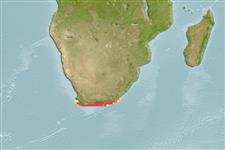Ikan bertulang rawan (sharks and rays) >
Carcharhiniformes (Ground sharks) >
Pentanchidae (Deepwater catsharks)
Etymology: Halaelurus: halos (Gr.), sea; ailouros (Gr.), cat, probably an allusion to the vernacular “catshark,” so named for its cat-like eyes (See ETYFish); natalensis: -ensis, Latin suffix denoting place: the coast of Natal, South Africa, type locality (See ETYFish).
More on author: Regan.
Environment: milieu / climate zone / depth range / distribution range
Ekologi
laut dasar (demersal); kisaran kedalaman 0 - 172 m (Ref. 5578). Subtropical; 33°S - 35°S
Southeast Atlantic: Cape Agulhas to East London in South Africa. Until recently, two species were confused under this name, the present one and the recently described Halaelurus lineatus (Ref. 244).
Size / Weight / umur
Maturity: Lm ? range ? - ? cm
Max length : 45.0 cm TL jantan/; (Ref. 244); 47.0 cm TL (female)
deskripsi pendek
Kunci identifiaksi (pengenalan) | Morfologi | Morfometrik
Duri punggung (Keseluruhan (total)) : 0; Duri dubur: 0. A catshark with a prominent upturned knob on the snout, a broad head, and with no spots on the body (Ref. 5578). Yellow-brown in color, with pairs of broad, vertical, dark brown stripes outlining dusky saddles (Ref. 5578), cream ventrally (Ref. 5510).
Found on the continental shelf, from close inshore to deeper water (Ref. 244). Feeds mainly on small bony fishes and crustaceans, also cephalopods and small elasmobranchs (Ref. 244).
Life cycle and mating behavior
Kematangan | Reproduksi, perkembang biakan | Pemijahan | telur-telur | Fecundity | Larva
Oviparous, with 6 to 11 egg-cases per oviduct (commonly 6 to 9) at a time (Ref. 244). Egg cases retained until embryos are well-advanced (Ref. 5578).
Compagno, L.J.V., 1984. FAO Species Catalogue. Vol. 4. Sharks of the world. An annotated and illustrated catalogue of shark species known to date. Part 2 - Carcharhiniformes. FAO Fish. Synop. 125(4/2):251-655. Rome: FAO. (Ref. 244)
Status IUCN Red List (Ref. 130435: Version 2024-2)
ancaman kepada manusia
Harmless
penggunaan manusia
Perikanan: perikanan swasembada; Ikan buruan: ya
Alat, peralatan
laporan khas
muat turun XML
Sumber internet
Estimates based on models
Preferred temperature (Ref.
123201): 15.7 - 21.9, mean 18 °C (based on 30 cells).
Phylogenetic diversity index (Ref.
82804): PD
50 = 0.5078 [Uniqueness, from 0.5 = low to 2.0 = high].
Bayesian length-weight: a=0.00355 (0.00175 - 0.00721), b=3.08 (2.90 - 3.26), in cm total length, based on LWR estimates for this (Sub)family-body shape (Ref.
93245).
Trophic level (Ref.
69278): 4.2 ±0.4 se; based on diet studies.
Daya lenting (Ref.
120179): Rendah, Waktu penggandaan populasi minimum 4.5 - 14 tahun (Fec assumed to be <100).
Fishing Vulnerability (Ref.
59153): Moderate vulnerability (37 of 100).
